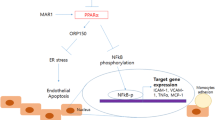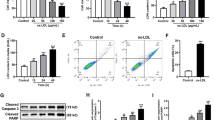Abstract
Atherosclerosis is a chronic cardiovascular disease and contributes to pathogenesis of most myocardial infarction and ischemic stroke. Additionally, N-methyl-d-aspartate (NMDA) receptor plays a crucial role in myocardial infarction and ischemic strokes. The aim of our study was to investigate the underlying mechanisms of memantine (MEM), the blocker of NMDA receptors, in the development of atherosclerosis. In our study, human umbilical vascular endothelial cells (HUVECs) were stimulated with low-density lipoprotein (ox-LDL) to establish an atherosclerotic cell model. Cell Counting Kit-8 (CCK-8) assay and TUNEL staining were performed to detect the cell activity and apoptosis of HUVECs, respectively. The levels of inflammatory cytokines and malondialdehyde and the activities of lactate dehydrogenase (LDH), superoxide dismutase (SOD), and caspase-1 were quantified with commercial assay kits. Finally, qRT-PCR assay and western blot analysis were carried out to determine the mRNA and protein expressions of inflammation-related genes in HUVECs. The results of the present study suggested that ox-LDL stimulation induced decreased viability of HUVECs, excessive inflammation, and oxidative stress, while these effects were counteracted by MEM treatment. Interestingly, MEM triggered the activation of BDNF/TrkB signaling pathway in HUVECs, and K252a, the inhibitor of the BDNF/TrkB pathway, abolished the suppressive effect of MEM on ox-LDL-induced inflammation, oxidative stress, and apoptosis in HUVECs. Overall, MEM attenuated ox-LDL-induced inflammation, oxidative stress, and apoptosis via activation of BDNF/TrkB signaling pathway in HUVECs, indicating that MEM may be defined as a novel and effective agent for atherosclerosis treatment.






Similar content being viewed by others
Abbreviations
- BDNF:
-
brain-derived neurotrophic factor
- HUVECs:
-
human umbilical vascular endothelial cells
- LDH:
-
lactate dehydrogenase
- MEM:
-
memantine
- NMDA:
-
N-methyl-d-aspartate
- ox-LDL:
-
low-density lipoprotein
- SOD:
-
superoxide dismutase
- TrkB:
-
tropomyosin-related kinase receptor type B
References
Zhu, L., X. Gong, J. Gong, Y. Xuan, T. Fu, S. Ni, L. Xu, and N. Ji. 2020. Notoginsenoside R1 upregulates miR-221-3p expression to alleviate ox-LDL-induced apoptosis, inflammation, and oxidative stress by inhibiting the TLR4/NF-kappaB pathway in HUVECs. Brazilian Journal of Medical and Biological Research 53: e9346.
Fava, C., and M. Montagnana. 2018. Atherosclerosis is an inflammatory disease which lacks a common anti-inflammatory therapy: how human genetics can help to this issue. A Narrative Review. Frontiers in Pharmacology 9: 55.
Shad, K.F., N. Luqman, A.M. Simpson, and S. Lal. 2018. Peripheral biomarker for vascular disorders. Biomarker Insights 13: 1177271918812467.
Dambinova, S.A., G.A. Khounteev, G.A. Izykenova, I.G. Zavolokov, A.Y. Ilyukhina, and A.A. Skoromets. 2003. Blood test detecting autoantibodies to N-methyl-D-aspartate neuroreceptors for evaluation of patients with transient ischemic attack and stroke. Clinical Chemistry 49: 1752–1762.
Sharp, C.D., J. Houghton, J.W. Elrod, A. Warren, T.H. Jackson, A. Jawahar, A. Nanda, A. Minagar, and J.S. Alexander. 2005. N-methyl-D-aspartate receptor activation in human cerebral endothelium promotes intracellular oxidant stress. American Journal of Physiology. Heart and Circulatory Physiology 288: H1893–H1899.
Ladagu, A.D., F.E. Olopade, O.R. Folarin, T.O. Elufioye, J.V. Wallach, M.B. Dybek, J.O. Olopade, and A. Adejare. 2020. Novel NMDA-receptor antagonists ameliorate vanadium neurotoxicity. Naunyn-Schmiedeberg's Archives of Pharmacology 393: 1729–1738.
Cheng, Q., L. Fang, D. Feng, S. Tang, S. Yue, Y. Huang, J. Han, J. Lan, W. Liu, L. Gao, and Z. Luo. 2019. Memantine ameliorates pulmonary inflammation in a mice model of COPD induced by cigarette smoke combined with LPS. Biomedicine & Pharmacotherapy 109: 2005–2013.
Wang, F., Z. Zou, Y. Gong, D. Yuan, X. Chen, and T. Sun. 2017. Regulation of human brain microvascular endothelial cell adhesion and barrier functions by memantine. Journal of Molecular Neuroscience 62: 123–129.
Liu, Y., Y. Huang, Y. Xu, P. Qu, and M. Wang. 2018. Memantine protects against ischemia/reperfusion-induced brain endothelial permeability. IUBMB Life 70: 336–343.
Freeman, M.R., V. Sathish, L. Manlove, S. Wang, R.D. Britt Jr., M.A. Thompson, C.M. Pabelick, and Y.S. Prakash. 2017. Brain-derived neurotrophic factor and airway fibrosis in asthma. American Journal of Physiology. Lung Cellular and Molecular Physiology 313: L360–L370.
Ravina, K., D.I. Briggs, S. Kislal, Z. Warraich, T. Nguyen, R.K. Lam, T.I. Zarembinski, and M. Shamloo. 2018. Intracerebral delivery of brain-derived neurotrophic factor using HyStem®-C hydrogel implants improves functional recovery and reduces neuroinflammation in a rat model of ischemic stroke. International Journal of Molecular Sciences 19.
Zhang, J.C., W. Yao, and K. Hashimoto. 2016. Brain-derived neurotrophic factor (BDNF)-TrkB signaling in inflammation-related depression and potential therapeutic targets. Current Neuropharmacology 14: 721–731.
Eyileten, C., A. Kaplon-Cieslicka, D. Mirowska-Guzel, L. Malek, and M. Postula. 2017. Antidiabetic effect of brain-derived neurotrophic factor and its association with inflammation in type 2 diabetes mellitus. Journal Diabetes Research 2017: 2823671.
Zhou, J., M. Wang, and D. Deng. 2020. KLF2 protects BV2 microglial cells against oxygen and glucose deprivation injury by modulating BDNF/TrkB pathway. Gene 735: 144277.
Childs, B.G., D.J. Baker, T. Wijshake, C.A. Conover, J. Campisi, and J.M. van Deursen. 2016. Senescent intimal foam cells are deleterious at all stages of atherosclerosis. Science 354: 472–477.
Cho, J.H., E.C. Kim, Y. Son, D.W. Lee, Y.S. Park, J.H. Choi, K.H. Cho, K.S. Kwon, and J.R. Kim. 2020. CD9 induces cellular senescence and aggravates atherosclerotic plaque formation. Cell Death and Differentiation 27: 2681–2696.
Jiang, Y.H., L.Y. Jiang, Y.C. Wang, D.F. Ma, and X. Li. 2020. Quercetin attenuates atherosclerosis via modulating oxidized LDL-induced endothelial cellular senescence. Frontiers in Pharmacology 11: 512.
Rodriguez-Manas, L., M. El-Assar, S. Vallejo, P. Lopez-Doriga, J. Solis, R. Petidier, M. Montes, et al. 2009. Endothelial dysfunction in aged humans is related with oxidative stress and vascular inflammation. Aging Cell 8: 226–238.
Li, W., Y. Li, Y. Zhao, and L. Ren. 2020. The protective effects of aloperine against ox-LDL-induced endothelial dysfunction and inflammation in HUVECs. Artificial Cells, Nanomedicine, and Biotechnology 48: 107–115.
Lowinus, T., F.H. Heidel, T. Bose, S.C. Nimmagadda, T. Schnöder, C. Cammann, I. Schmitz, et al. 2019. Memantine potentiates cytarabine-induced cell death of acute leukemia correlating with inhibition of K(v)1.3 potassium channels, AKT and ERK1/2 signaling. Cell Communication and Signaling 17: 5.
Lü, W., J. Du, A. Goehring, and E. Gouaux. 2017. Cryo-EM structures of the triheteromeric NMDA receptor and its allosteric modulation. Science 355.
Cherubini, E., S. Mariotta, D. Scozzi, R. Mancini, G. Osman, M. D’Ascanio, P. Bruno, G. Cardillo, and A. Ricci. 2017. BDNF/TrkB axis activation promotes epithelial-mesenchymal transition in idiopathic pulmonary fibrosis. Journal of Translational Medicine 15: 196.
Zhu, L., X. Gong, J. Gong, Y. Xuan, T. Fu, S. Ni, L. Xu, and N. Ji. 2020. Notoginsenoside R1 upregulates miR-221-3p expression to alleviate ox-LDL-induced apoptosis, inflammation, and oxidative stress by inhibiting the TLR4/NF-κB pathway in HUVECs. Brazilian Journal of Medical and Biological Research 53: e9346.
Goldstein, J.L., and M.S. Brown. 2015. A century of cholesterol and coronaries: from plaques to genes to statins. Cell 161: 161–172.
Salvayre, R., A. Negre-Salvayre, and C. Camarﺃﺏ. 2016. Oxidative theory of atherosclerosis and antioxidants. Biochimie 125: 281–296.
Roberts, C.K., and K.K. Sindhu. 2009. Oxidative stress and metabolic syndrome. Life Sciences 84: 705–712.
Hashimoto, M., Y. Tanabe, S. Hossain, K. Matsuzaki, M. Ohno, S. Kato, M. Katakura, and O. Shido. 2020. Intake of alpha-linolenic acid-rich Perilla frutescens leaf powder decreases home blood pressure and serum oxidized low-density lipoprotein in Japanese adults. Molecules: 25.
Lupfer, C., P.G. Thomas, P.K. Anand, P. Vogel, S. Milasta, J. Martinez, G. Huang, M. Green, M. Kundu, H. Chi, R.J. Xavier, D.R. Green, M. Lamkanfi, C.A. Dinarello, P.C. Doherty, and T.D. Kanneganti. 2013. Receptor interacting protein kinase 2-mediated mitophagy regulates inflammasome activation during virus infection. Nature Immunology 14: 480–488.
Li, R., X. Mi, S. Yang, Y. Yang, S. Zhang, R. Hui, Y. Chen, and W. Zhang. 2019. Long-term stimulation of angiotensin II induced endothelial senescence and dysfunction. Experimental Gerontology 119: 212–220.
Li, L., A.L. Yu, Z.L. Wang, K. Chen, W. Zheng, J.J. Zhou, Q. Xie, H.B. Yan, P. Ren, and X. Huang. 2019. Chaihu-Shugan-San and absorbed meranzin hydrate induce anti-atherosclerosis and behavioral improvements in high-fat diet ApoE(-/-) mice via anti-inflammatory and BDNF-TrkB pathway. Biomedicine & Pharmacotherapy 115: 108893.
Funding
This work was supported by Key Disciplines Group Construction Project of Pudong Health Bureau of Shanghai, China (Grant No. PWZxq2017-05), and the Top-level Clinical Discipline Project of Shanghai Pudong, China (Grant No. PWYgf2018-02).
Author information
Authors and Affiliations
Corresponding authors
Ethics declarations
Conflict of Interest
The authors declare that they have no conflicts of interest.
Additional information
Publisher’s Note
Springer Nature remains neutral with regard to jurisdictional claims in published maps and institutional affiliations.
Rights and permissions
About this article
Cite this article
Hao, Y., Xiong, R. & Gong, X. Memantine, NMDA Receptor Antagonist, Attenuates ox-LDL-Induced Inflammation and Oxidative Stress via Activation of BDNF/TrkB Signaling Pathway in HUVECs. Inflammation 44, 659–670 (2021). https://doi.org/10.1007/s10753-020-01365-z
Received:
Revised:
Accepted:
Published:
Issue Date:
DOI: https://doi.org/10.1007/s10753-020-01365-z




